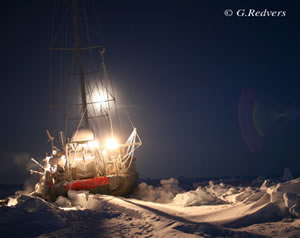
 |
Tara's incredible polar driftDecember 10, 2007Courtesy of Far North Science 
Tara has spent two winters in the ice In the deep blackness of the polar night, the research schooner Tara and its crew of a dozen well-insulated scientists have been drifting for the past 15 months and now are veering mile by mile with Arctic ice toward the frigid waters of the North Atlantic Ocean. With a rounded, flat hull, and reinforced structure, the ship embedded itself in polar ice in September of 2006. With scientists measuring ice thickness and taking observations, the boat traveled with floes about 5.7 miles per day during the first 12 months. In the end, Tara has moved about 870 miles across the Arctic - yet actually covered a more than of 2,100 miles due to the zigzag vagaries of the ice cap. On May 28, the vessel slipped north of 88 North - within 100 miles of the geographic North Pole. Over the summer, the ship began drifting south faster than expected, and could reach open water within the next few weeks. (This emergence is a topic of keen interest to the crew. "Despite all of the chatter, modeling, predictions and general banter, we just don't know how things will pan out," they wrote on Nov. 21. "That's part of the magic of being stuck up here, to be living in a world that is not governed by bus timetables and the certitudes of what tomorrow will bring." Life aboard can be intense and frustrating. Blizzards trap the crew indoors for days. When the wind lets up, they must emerge into air liquid with cold and begin to dig. They describe the tension between the two as the The Spade and the Beast - the shovel and the wind. Indeed, the wind moves impressive quantities of snow around. In a week, the total hull of Tara, except for the boat's back has been covered by a gigantic white compact wave. The nose of the schooner barely stuck out from the snow. This morning as of 9 o'clock, the first diggers, started working to release Tara from her thick white cover. Finally, a single day will not be sufficient and more digging will be necessary tomorrow and after tomorrow to free the hull's sides. The crew keeps a lively web blog updated at least once a week, and has posted an impressive (if not eerie collection) of photographs from life amid the vast polar cap.
Here's a dispatch about a dive operation - beneath the Arctic night, into the frozen sea: Diving suits, torch lamps, life line, camera, one person is needed to help the ice divers to put their equipment on and to manage their surface safety. A full hour is necessary to prepare them for this immersion that lasts but a couple of minutes. Indeed, the air temperature of minus 26 °C, the pitch black night and a water under ice by minus 1.8 °C do not make this dive easy under the pack ice. Underneath the ice, in contrast with the total lack of light, our lamps pierce through crystal clear water. Indeed, at this time of the year, water particles are scarce. The view is strikingly pure. |
|